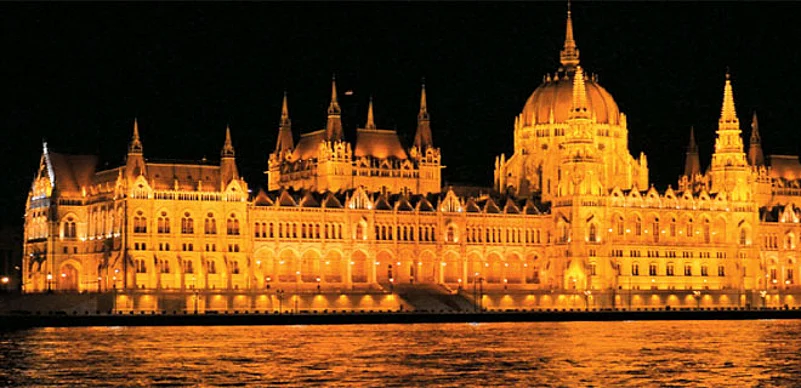When Delhi was burning at 41 degree Celsius we boarded an Emirates flight to Budapest, for a lovely summer vacation.
After a twelve hour journey we were outside Budapest Ferenc Liszt International Airport trying to negotiate fares with the cabs to our hotel Courtyard by Marriott at Budapest City Center. Even though travel websites and books spoke highly of the city, deep inside I had expected to see some traces of an ex-communist country. However, the clean wide roads with modern buildings and high rises didn’t quite fit the bill.
The bisected city
After quickly exchanging notes with our friends on our research about the rest of the trip, we decided to stroll down to Elisabeth Bridge named after Elisabeth of Bavaria who was assassinated in Geneva, Switzerland. During World War II this bridge was blown away by the Germans and in its place now stands the sleek, modern white cable bridge over the narrowest part of the Danube. The mighty Danube connects the two parts of the city— Buda and Pest. Buda contains the historical heritage of the city while Pest is the city center with polished buildings, clubs and shopping plazas. On day one, after a quick dinner at a local restaurant we called it a night.
Advertisement
Next morning, we hopped on to a city tour bus. Our first stop was the Széchenyi Chain Bridge. It’s one of the best places to get breathtaking views of the Castle District, looming above the city. From the Chain Bridge one can either take a bus trip to the Castle District or a ride on the funicular. Though a fleeting one, the view from the funicular was spectacular.
The Castle Hill consists of the Royal Palace, Matthias Church, medieval houses, museums, the Fishermen’s Bastion and some charming cafes and restaurants. Cobbled streets dotted with baroque buildings gave a story bookish sense to the place.
Advertisement
Matthias Church on Castle Hill is breath-taking, more so because of its setting. The area provides a panoramic view of the Parliament building and the Danube River. The original church was vandalized and turned into a mosque by the Ottoman Empire, but was restored later in the 17th century. Like many other structures in Budapest, Matthias Church too was destroyed in World War II. At present, the 700-year-old church with its colourful ceramic roof and al fresco paintings inside shows no signs of the storms of history that it has weathered.
We wandered to the Fisherman’s Bastion which is mainly a lookout point and were lucky to catch the Farmers’ Market where we shopped for inexpensive souvenirs, clothes and gorged on delicious local food.
From the church square, we walked down the hill to Dísz Square, the hub of Castle District. The place is packed with restaurants where we stopped to taste the local fruit wine available in almost all kinds of fruit flavours that one could think of. Walking further down we passed a huge iron gate with the Turul bird perched on top, which is an important symbol of Hungary. The landscape overlooked the majestic Danube and the Pest side of the city.
The Hungarian Parliament building was the star attraction on the Danube. We decided to skip the tour inside as we had many more sights to see. We boarded the city tour bus again which took us along the elegant Andrássy Avenue to the Heroes’ Square. The square was built to celebrate 1000 years of the Hungarian state.
Advertisement
A five minute walk from the square took us to the Széchenyi Baths, one of the largest thermal baths in Budapest. Aqua therapy, we were told, is a regular medicine practice in Hungary and the thousands of natural warm spring water bodies available in the country makes it easier.
Our next stop was the Dohany Street Jewish Synagogue, one of the largest in Europe. One can enter the synagogue for free to enjoy the beautiful gold accented designs of the interiors. We took a walk to the garden where a cemetery on the further side of it stood as a reminder of the historical circumstances. The memorial park had a weeping willow structure with metallic leaves dangling from it that had the names of all the Jews killed during the Holocaust.
Advertisement
The grand finale
Later that evening, we took a cruise along the Danube, tickets for which were purchased from the hotel. Once our boat started cruising along the river we realised why the Danube, Castle Hill, Gellért Hill, and several other landmarks in Budapest are on the UNESCO World Heritage list. The spectacle was similar to that of a grand wedding. Every building of importance was lit up and it almost felt unreal to be able to witness it. The waters of the Danube seemed to come alive with the reflections of the lit-up buildings. There were drinks and snacks available for people to buy on the two-storey boat that we chose. After clicking innumerable pictures from various directions, we decided to close the shutters and just absorb the surroundings. It was a perfect closure to our trip.
Advertisement
We also took out time to visit Vajdahunyad Castle, Hungarian State Opera House and walked down the Danube Promenade. However, we had to give few places a miss, like the Gellért Hill Cave, Hungarian National gallery due to time constraints and we were also looking forward to Bratislava, Prague, Vienna and Salzburg.
Fun Facts
- The movie The Grand Budapest Hotel was not filmed in Budapest but in Germany.
- The statues of the lions at the end of Chain Bridge appear to have no tongues, as the tongues cannot be seen from below.
- The inventor of Rubik’s Cube was born in Budapest.
- The origin of Hungarian and Finnish language have more than 500 words in common.
Advertisement
Tips for Travel
How to reach Budapest: Get a Schengen visa and a ticket on one of the various airlines from the major cities in India.
Best Time to visit: Between April and September. Winters are harsh and temperatures can go down to -5 degree Celsius with biting cold winds.
Expenses: Budapest is relatively cheaper than other European cities. You can have a hearty meal at $5. There are wine shops across the city if you want to drink local wine and beer. Grab a bottle on the go. Budget hotel accommodation ranges from $40 to $60.
The Food Trail
Food in Budapest is reasonably priced and the place is a meat lover’s heaven. Hungarian sausages and salamis with pickled onions and thin soup is the most popular local food, and we couldn’t have enough of it. Some were smoked, others boiled or just sautéed with garlic, onions and a dash of pepper, nutmeg and local spices.
Goulash, the traditional dish of Hungary, is in between a meat stew and soup. Cooked with Goulash is available in almost all restaurants in Budapest and tastes almost the same. We also tasted the fisherman’s soup, chicken paprikash (chicken in creamy sauce served with dumplings) and Langos (fried bread with various toppings sweet and savoury). For dessert, we had the Kürtoskalács or a pull apart cake that is rolled in sugar, cinnamon, nuts or chocolate flakes. The cake is hollow inside and is baked in a rotisserie over charcoal. It is easily available in bakeries as well as street shops all over the city.
Chumki Sen is Assistant Director, Bookaroo Children’s Literature Festival















 Just one email a week
Just one email a week